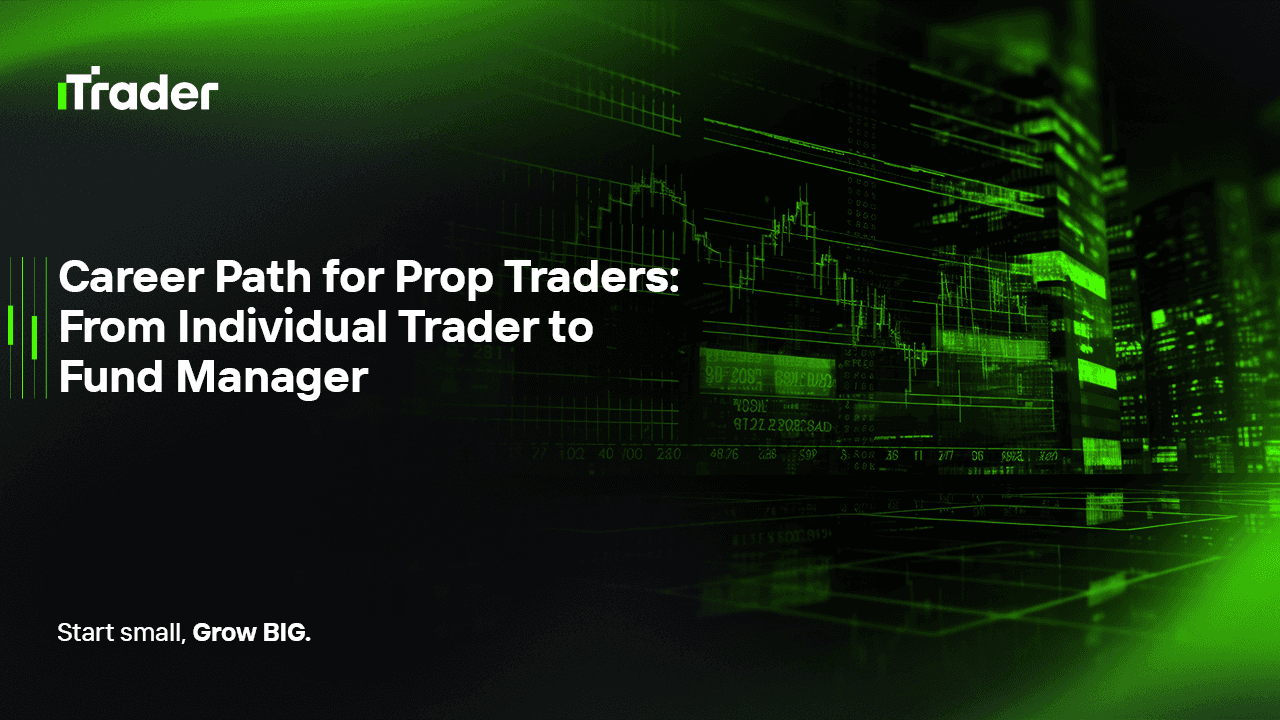2025-09-19
In the world of forex and financial markets, becoming a prop trader is a dream for many. Passing a prop firm’s evaluation and gaining access to capital without risking personal funds is a huge milestone. Yet, this is not the endpoint. On the contrary—it marks the beginning of a much broader career trajectory, where an independent trader can evolve into a portfolio manager and, ultimately, an asset manager.

This blog explores the career path of prop traders across five major stages, highlighting the goals, skills, and challenges at each level, as well as the future trends shaping this journey.
At this stage, discipline is everything. While strategy, indicators, and technical knowledge matter, they are never enough on their own. The real test lies in the psychological ability to accept losses.
Most traders fail prop evaluations due to over-leverage or impatience. This stage is essentially survival school—learning how to last long enough to build consistency.
Once an independent trader shows stable profitability, they often gain access to larger allocations within the prop firm. At this stage, the goal shifts from mere survival to institutional-grade performance.
Many traders at this stage sabotage themselves by trying to expand too quickly—juggling too many strategies at once and destabilizing their equity curve.
As advanced traders mature, they often begin collaborating with peers. At this stage, traders focus not only on their personal performance but also on contributing to a team or “strategy desk.”
Trust, transparency, and communication become central. A trader must respect not only their own discipline but also the team’s collective approach.
This stage represents a major career transition. Moving beyond prop firm capital, traders can attract external investors if they prove consistent performance.
The biggest obstacle is bridging the gap between personal trading style and institutional standards. For investors, profitability matters—but long-term stability and risk control matter even more.
The final stage is reaching the level of an asset manager. At this point, the trader is no longer just an operator but becomes a business owner managing capital at scale.
At this level, success requires a balance of technical expertise, business acumen, and interpersonal skills—a demanding combination that separates professionals from amateurs.
The career of a prop trader does not end with passing a firm’s evaluation. It is the beginning of a multi-stage progression:
At every stage, the keys remain the same: discipline, transparency, and reputation. With these, any trader can evolve from trading a small account to managing millions in investor capital.
© 2025 iTrader Global Limited | หมายเลขทะเบียนบริษัท: 15962
iTrader Global Limited ตั้งอยู่ที่ Hamchako, Mutsamudu, เกาะปกครองตนเอง Anjouan, สหภาพคอโมโรส และได้รับใบอนุญาตและอยู่ภายใต้การกำกับดูแลของคณะกรรมการหลักทรัพย์แห่งคอโมโรส ภายใต้หมายเลขใบอนุญาต L15962/ITGL
iTrader Global Limited ดำเนินการภายใต้ชื่อทางการค้า “iTrader” และได้รับอนุญาตให้ดำเนินกิจกรรมการซื้อขายฟอเร็กซ์ โลโก้ เครื่องหมายการค้า และเว็บไซต์ของบริษัทเป็นทรัพย์สินเฉพาะของ iTrader Global Limited
บริษัทย่อยอื่น ๆ ของ iTrader Global Limited ได้แก่ iTrader Global Pty Ltd หมายเลขทะเบียนบริษัทออสเตรเลีย (ACN): 686 857 198 โดยบริษัทนี้เป็นตัวแทนที่ได้รับอนุญาต (หมายเลขตัวแทนบริการทางการเงินของออสเตรเลีย (AFS): 001315037) ของ Opheleo Holdings Pty Ltd (ใบอนุญาตบริการทางการเงินของออสเตรเลีย (AFSL): 000224485) ซึ่งมีที่อยู่จดทะเบียนอยู่ที่ Level 1, 256 Rundle St, Adelaide, SA 5000 ข้อจำกัดความรับผิดชอบ: นิติบุคคลนี้ไม่ใช่ผู้ออก และไม่รับผิดชอบต่อผลิตภัณฑ์ทางการเงินที่ซื้อขายบนหรือผ่านเว็บไซต์นี้
คำเตือนความเสี่ยง: การซื้อขาย CFD มีความเสี่ยงสูงต่อการสูญเสียเงินทุนอย่างรวดเร็วเนื่องจากเลเวอเรจ และอาจไม่เหมาะสมกับผู้ใช้ทุกคน
การซื้อขายกองทุน CFD และผลิตภัณฑ์ที่มีเลเวอเรจสูงอื่น ๆ ต้องการความรู้เฉพาะทาง
จากผลการวิจัยพบว่า 84.01% ของผู้เทรดที่ใช้เลเวอเรจประสบกับการขาดทุน
โปรดตรวจสอบให้แน่ใจว่าคุณเข้าใจความเสี่ยงทั้งหมด และพร้อมที่จะสูญเสียเงินทุนก่อนที่คุณจะเข้าร่วมการซื้อขายที่มีเลเวอเรจ
iTrader ขอประกาศว่า บริษัทจะไม่รับผิดชอบต่อความเสี่ยง ความเสียหาย หรือการสูญเสียใด ๆ ที่เกิดขึ้นจากการซื้อขายแบบมีเลเวอเรจต่อบุคคลหรือนิติบุคคลใด ๆ ทั้งสิ้น
ข่าวสารและข้อมูลที่ปรากฏบนเว็บไซต์นี้มีไว้เพื่อวัตถุประสงค์ทางการศึกษาเท่านั้น ผู้ใช้ควรตัดสินใจทางการเงินอย่างอิสระและโดยใช้ข้อมูลอย่างรอบคอบ
ข้อจำกัด: iTrader ไม่ได้มุ่งเป้าเว็บไซต์หรือบริการไปยังผู้อยู่อาศัยในประเทศที่กฎหมายหรือข้อบังคับห้ามไม่ให้มีการทำธุรกรรมดังกล่าว
หากคุณอาศัยอยู่ในเขตอำนาจที่การใช้เว็บไซต์หรือบริการนี้ถูกจำกัด คุณต้องรับผิดชอบในการปฏิบัติตามกฎหมายท้องถิ่น
iTrader ไม่รับประกันว่าเนื้อหาบนเว็บไซต์ของบริษัทจะเหมาะสมหรือถูกต้องตามกฎหมายในทุกพื้นที่